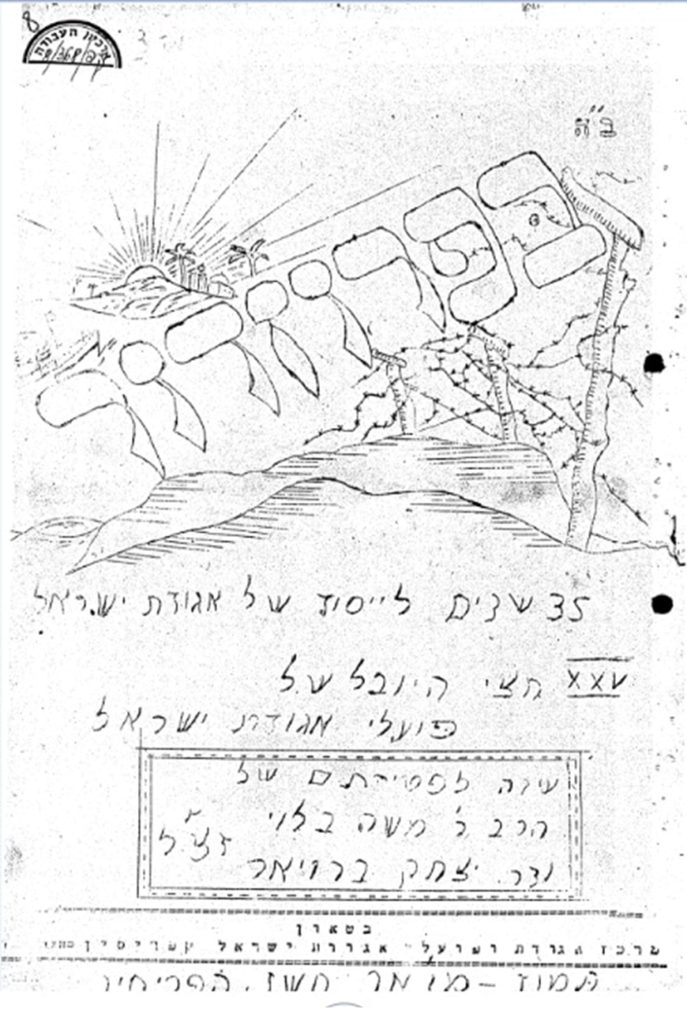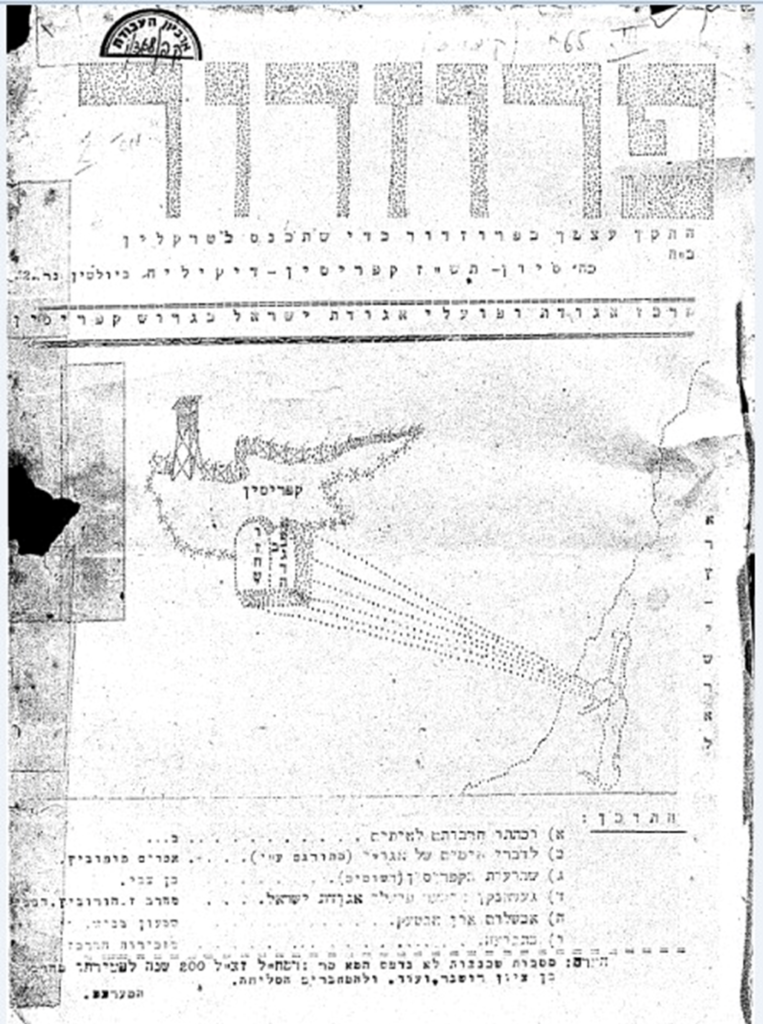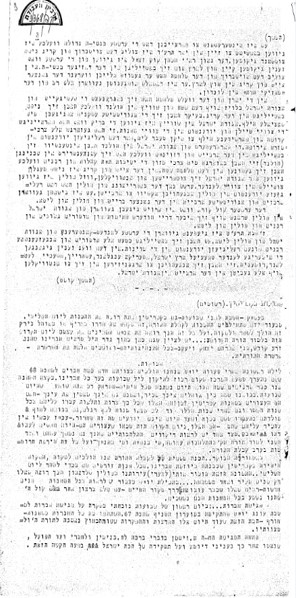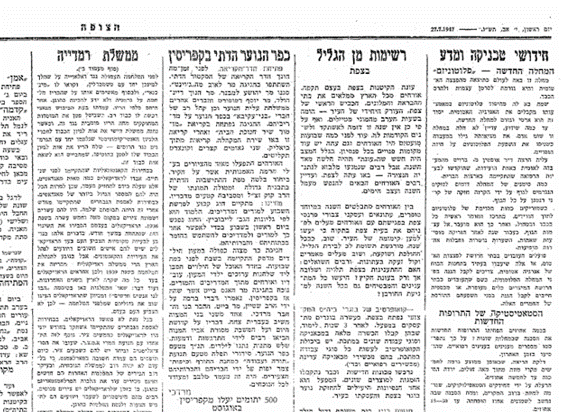“Be Ready for 3 Days” (Exodus 19:15): Receiving the Torah in the Cyprus Detention Camps 5707 (1947)
“On Shabbat eve the Shabbat before Shavuot, also in Cyprus one seens the preparations for Tuesday.” A porthole opens with these words, going back in time, reflecting the feeling of elation towards the holiday of the giving the Torah among those imprisoned in Cyprus.
By: Devorah Surasky
Who is the author? And when and where was the description written?
Yehoshua Should Publish a Newspaper: “Newspapers in the Detention Camps”

Cover of the “Prozdor” Newspaper, Tamuz 5707 (Summer 1947)
On Nisan 25, 5707 (April 15, 1947), 2700 illegal immigrants arrived in Cyprus aboard the “Theodore Herzl” ship; amongst them were about 170 illegal immigrants who were connected to Poalei Agudath Israel and Agudath Israel. “The Landsberg Group” was the most prominent group of the immigrants, and it included Rabbi Shimon Benisch, the spirit of the group.
The month of Iyar 5707 (spring 1947) is marked in the chronology of the Poalei Agudath Israel movement as a turning point. Starting from this period, the activities of the movement were organized and it grew and expanded to a variety of enterprises.
During the time Rabbi S. Benisch spent in Cyprus as a detainee, he contributed much to the spiritual life in the camps.[1] The founding of the Poalei Agudath Israel movement and the consolidation of its activities are attributed to him, and his stamp is imprinted on the entire range of its activity.
“Yehoshua needs to publish a newspaper” – this is how Yehoshua Eibeshitz, who was an illegant immigrant on the “Theodore Herzl” ship, described the determination of Rabbi S. Benisch who said: “A newspaper is not like a sermon or a speech. The people treat the printed word with respect, the newspaper will drip a Torah view of life. A newspaper will make our voice heard in all camps, and give the feeling that we are a big movement.” [2] Rabbi S. Benisch was not content with reading. As a practical man, he obtained a typewriter and began his activity.
The artistic talent of Rabbi S. Benisch and the creative thinking that characterized him were expressed in the “homemade” newspaper, in accordance with the conditions in the detention camp. The varied cover decorations of the newspaper reflected the longing for liberation, and the name of the newspaper, “Prozdor” (Corridor), also expressed their reality engulfed in hope – a temporary stop on the way to the living room – to the Land of Israel. His spirit was present in the pages of the newspaper – apparently he often wrote under different pen names: S. Lodzai, S. B., and more.[3] The publications were published monthly, from the summer of 5707 (1947).[4] The original six booklets are held in the HaAvoda Archive.[5]
The illegal immigrants in the camps were anchored in “movement groups”, and the activity of the movements was a source of strength that motivated and supported them. The joint confrontation with their fate and the challenges of their lives under the umbrella of the movement formed an anchor and created meaning for the detainees in Cyprus.
The entire daily life regarding living spaces, the kitchen, employment, and socialness, was built with the cooperation of the members of the movement, and a lively cultural life was conducted between the tents and the huts. During the two and a half years of operation of the detention camps, about 80 pamphlets and leaflets were published in them. The leaflets bore names that recall the reality of captivity on the one hand and the hope on the other hand, such as “BaGirush” (In Exile) – a publication of HaShomer HaTza’ir, “BaTerem” (In the Meantime), “BaMidbar” (In the Desert), “BaMaatzar” (In Custody), “Geder Til” (Barbed Wire Fence), “Al HaSaf” (On the Threshold) – the weekly of the Rotenberg Seminary, “BeNetiv HaPedut (In the Path of Redemption) – of the Hapoel HaMizrachi movement, and “Prozdor” (Corridor) – as mentioned, the publication of Poalei Agudath Israel.
The publications were written in the many languages of the illegal immigrants: Yiddish, Hebrew, Romanian, Hungarian, and Polish. The “Prozdor” publication was published in Yiddish and Hebrew.[6]
“And the entire nation saw the voices…” (Exodus 20:15)
“From Afar You Heard that Today is Shavuot”: Shavuot 5707 (1947) in the Eyes of a Writer in the “Prozdor” Publication

The cover of an edition of “Prozdor,” Sivan 28, 5707 (June 16, 1947)
In the Sivan 28, 5707 (June 16, 1947) edition of “Prozdor,” the title “Shavuot in Cyprus – Records” appears in the table of contents; the author: Ben Sevi (pen name). The cover decoration of the newspaper symbolizes the reception of the Torah in captivity in the Cyprus desert, and it combines the illustration of the Ten Commandments with the description of the island of Cyprus fenced with barbed wire and a guard tower, plus arrows pointing to Israel. The lines reflect an emotional image that connects the reader to the time and place.
“On Shabbat eve, the Shabbat before Shavuot, even in Cyprus you see the preparations for Tuesday. Preparations for receiving the Torah begin a day in advance. One decorates his room in a shack or tent with greenery. One goes to the barber and the mikva (ritual bath). And for all of these you see people preparing themselves for this holy day by studying the holy Torah.”
“Shavuot, first night. After the holiday feast, we go together with some friends to Camp 68, where the centre has organized a gathering place for the Shavuot night Torah study session for all our members. At the end of the camp we already feel that something today will be different from other days. From a long distance you hear that today is Shavuot.”
“On one side, one can see passionate dancing, which one is also attracted to. And on the other side, are people studying the holy Torah with great enthusiasm, some immersed in the Gemara with the commentaries of Rashi and Tosfot, and some in Tanach (Torah, Prophets, and Writings). And everyone is in awe of the exaltation of the eve of receiving the Torah.”
The writer of the lines also writes about the group of the girls who gathered at the club in Camp 67: “All the girls participated…” The description goes into detail about the feeling of elation at the holiday of receiving the Torah among the girls and about a conversation that took place “about current affairs and the role of Jewish girls in this difficult time”.
The writer shares his astonishment at the strength of spirit of the detainees: “When we come to the place among the tents, one does not recognize and indeed one does not believe what one sees. Are they the detainees in the Cyprus camps?…”.
“…Yes! They are the ones who went through so much trouble and hardship in all the years of destruction, and even after these years they still have not found rest. Even when they came to the shore of their homeland, they were forcibly displaced from there, and to this day they do not know what liberation is. However, now one cannot recognize that these people are them. On this holy day, they forgot that they are prisoners. Today they are free to serve G-d.”

A page from an edition of “Prozdor”
The feeling of the highness of the holiday enveloped many, and even awakened the Jewish identity of those far from Jewish practice: “At holiday prayers, one can see many ‘new faces’ in the group in the camps, of those who have already left the path of the source of life. Voluntarily or not – the voice of G-d that is heard in all the camps – calls them and they continue…”
“The Angels Rejoiced and People Rejoiced, with the Receiving of the Torah at Mount Sinai” (traditional Shavuot prayer): A Bar Mitzvah Celebration during the Holiday of Receiving the Torah
In the religious youth village in Camp 65 of the “Torah V’Avoda” (Torah and Work) movement, a bar mitzvah was celebrated for two children on Shabbat – the eve of Shavuot – in the presence of many guests.[7]

From an edition of HaTzofeh, July 1947
“The Religious Youth Village in Cyprus” – a short headline in the “HaTzofeh” newspaper issue of July 27, 1947 (above) is the introduction to the article reporting on the exciting event: “A double bar mitzvah celebration at the centre for children from Deszk… In the children’s dining room, the children of the centre sat at the prepared tables, his workers and guests… Words of blessing were said by Rabbi Stein… One of the two bar mitzvahs boys replied in clear Hebrew. His words about the sanctity of the day and the continuation of his father’s tradition were emotional and brought many to tears.”[8]
“The Children of Deszk” were around 100 children who were educated in the “Bnei Akiva” youth village established for child Holocaust survivors in the village of Deszk in south-east Hungary. After the war, they sailed on the “Knesset Yisrael” ship and were educated in the autonomous religious youth village of “Bnei Akiva” that operated in the general youth village in the Winter Camp 65. Rabbi Mordechai Stein, later rabbi of Moshav HaZorim, came with the “Children of Deszk”, and was active in the “religious council” in the winter camps. In the religious youth village, Rabbi Stein served as head of the Bnei Akiva yeshiva, which was the highlight of the village.[9] At the aforementioned bar mitzvah celebration, the rabbi gave a sermon in Hebrew.
“It should be noted that even here, inside the barbed wire fence, our members show that they are the holy descendants of the sons of Avraham, Yitzchak and Yaakov, in all their behaviors, and they pull the chain of Torah onward.” (Prozdor)
[1] Rabbi Shimon Benisch (5672-5768/ca. 1912-2008), a man of great deeds, the operator of the Poalei Agudath Israel movement. His activity spans many stations: in Lodz, in labour camps, in the Landsberg displaced persons camp – where he took care of educational institutions, in the detention camps in Cyprus – where he organized religious life as the chairman of Poalei Agudath Israel, and in Israel. For more information on his actions, see the book published by the family: H. Benisch, “Ish Lehava”: Dmut Diukno U’Masechet Chayav HaMufla Shel Sarid HaKavshanim HaRab Shimon Benisch z”l, Ish Chai Rav Pe’alim.
The information about his activities and the activities of Poalei Agudath Israel in Cyprus as presented here is based on what is written in the book.
[2] H. Benisch, “Ish Lehava,” chapter 39: Mi’Iton LeVe’ida, Bnei Brak, 5775 (2014-5), pg. 342.
[3] Ibid.
[4] D. Sheari, “Girush Kafrisin”: HaApala, HaMachanot, U’Chevrat HaMaapalim, 1946-1949, chapter 4: HaTnuot, Jerusalem, 1981, pg. 291.
[5] HaAvoda Archive, Lavon Institute, Tel Aviv.
[6] M. Naor “BaYam, BaYabasha, V’Gam BaAvir,” chapter 6: Machanot Kafrisin – Perek Sheh’ein Lo Ach, Israel 2015, pg. 113; Dr. Sheari pgs. 265, 291.
Thanks to Mr. Amir Rogel, of the “Maapilei Kafrisin” organization, for sending the editions of “Prozdor.”
[7] M. Weinstein, “Tzionut Datit BeShulei Eretz Yisrael”: Tnuat Torah VeAvoda BaMachanot HaMeatzar BeKafrisin, chapter 3: Kfar HaNoar Hadati BaMachanot Kafrisin, Israel 2001, pg. 103.
[8] Historical Jewish Press site, founded by the National Library and Tel Aviv University, www.JPRESS.org.il.
[9] M. Weinstein (above, note 7) pgs. 90, 106-107.












